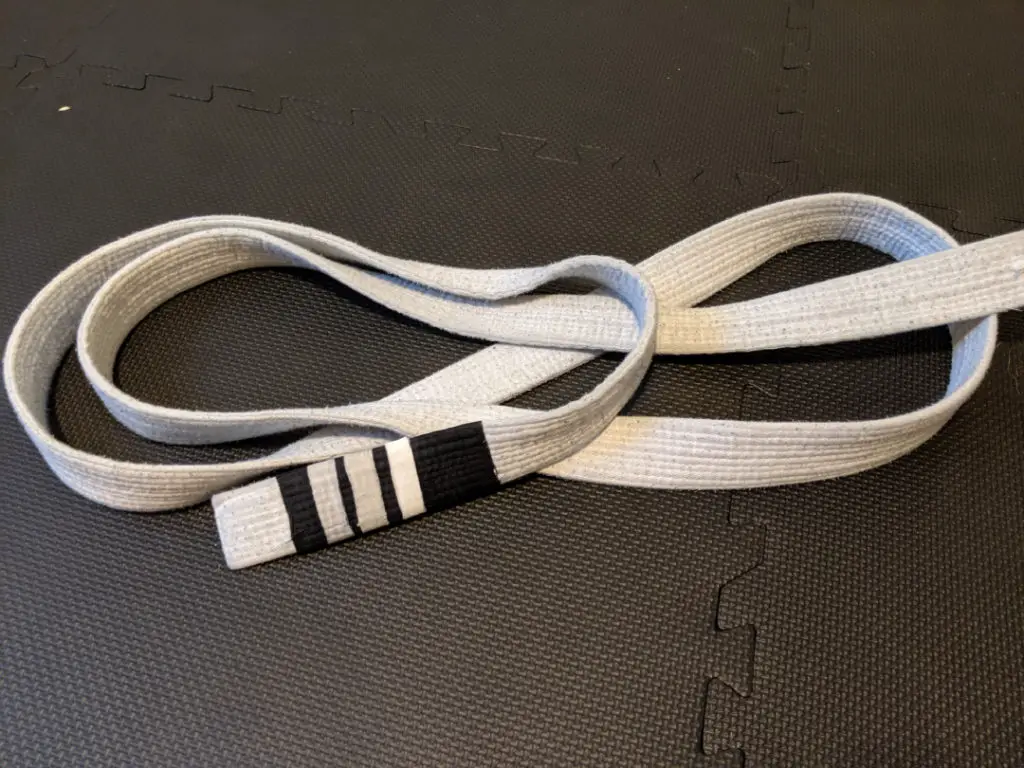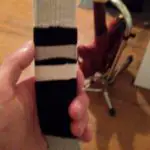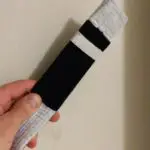To achieve the third stripe on your white belt will take training regularly, refining details in fundamental techniques you’ve been taught, experimenting, and incorporating new techniques you’ve learned. You can expect to get your 3rd stripe 4-8 months after your second stripe, or 1-2 years into training.
Each instructor will have their own requirements, so be sure to ask them to clarify if you are concerned!

What Do Three Stripes Mean On a White-Belt?
A student with a third stripe on their white belt typically means the student has been training for over a year, understands and can demonstrate fundamental techniques, and has submissions or positions they favor. Students with 3 stripes on their white-belt do not necessarily mean they are better at rolling than a student with 1 stripe.
Keep in mind that some Jiu-Jitsu instructors do not use strips, thus there are some white-belts (or even blue, purple, or brown) that do not have any stripes but have been training longer than someone with 1-4 stripes.
Stripes are usually only used to either motivate the student or so that the instructor can keep track of each student’s progress, knowledge/skill level, or time training.
How Long Does It Take To Get The Third Stripe?
The third stripe is generally awarded to students after 1-2 years of consistent training. Of course, this is dependent on the instructor’s criteria for awarding the third stripe. The student may be required to train for 1-2 years, demonstrate techniques and technical knowledge, or a combination of all of those.
What Is Required To Get Your Third Stripe?
Many aspects can contribute to receiving your 3rd stripe in Jiu-Jitsu, some of which are: consistent training, technical ability, and instructor requirements. Below is a table naming some of the technical abilities you have learned or are refining as you progress towards your 3rd stripe.
| Positions | Sweeps | Passes | Escapes | Submissions |
| Guard | Hip-Bump | Toreando | Bridging | Arm Bar(s) |
| Open Guard | Scissor | Stacking/Under The Leg | Shrimping | Triangle Choke |
| Half-guard | Tripod | Folding the Knees | Knee-Elbow | Kimura |
| Side-Control | Pendulum | Leg Drag | Technical Stand-up | Americana |
| Mount | Lumberjack | Knee-Cut | Triangle Defense | Bow n’ Arrow |
| Back-Mount | Butterfly Sweep | Step-Through | Arm Bar Defense | North-South Choke |
| Knee-On-Belly | Back Mount Escape | Rear-Naked Choke (RNC) | ||
| Butterfly | Collar Choke | |||
| Turtle | Arm Lock | |||
| Kesa Gatame |
Consistent Training
Consistent training shows that you are engaged in class and are actively trying to learn more about Jiu-Jitsu. You’re getting more time on the mats to refine your technical ability and try new techniques.
Consistent training doesn’t mean more training per week, it simply means you’re showing up to class regularly. Showing up to class regularly will help you retain the techniques you are being taught and refine those techniques during rolling each time you go.
Technical Ability
Technical ability in Jiu-Jitsu will get you moving through the ranks quickly. It is possible to skip stripes and it’s not unheard of to see a 2 or 3 stripe white belt to get promoted to blue (I’ve seen it in my class!). You also don’t have to be the most athletic person in class or the youngest.
Improving upon your technical ability will help you excel and that doesn’t mean you need to be submitting everyone. Learning new escapes, sweeps, or defense and refining those moves is building technical knowledge and ability.
Instructor Requirements
Each instructor and school will have their requirements for promotions, whether that is your 3rd stripe on your white belt, blue belt, or purple belt with 2 stripes.
They may be watching to see how you learn and incorporate techniques into your rolling and/or situational drills.
Other times, they may recognize that you are consistently coming to class. You may be eligible for your stripe because they know you have been putting in the work.
The best way to find out what it’ll take to get your 3rd stripe, although, try not to focus on stripes or promotions as this is not the point of Jiu-Jitsu, is to ask your instructor directly about their requirements.
Note: Getting promoted to purple, brown, black, and each stripe on the black belt does have requirements that have to be met to be officially recognized by the IBJJF. If you want to find out more about those requirements check out my article, What You Need To Know About Jiu-Jitsu Promotions.
What It Took For Me To Get My Third Stripe
When I got my second stripe it caught me off guard, so I wanted to make sure that when I got my third stripe I felt like I deserved it. Of course, do not let this discourage you when you do not receive it, and don’t burn yourself out either!
My Game Plan As I Worked My Way To My Second Stripe
Throughout my second stripe, I found myself using the same techniques during rolling. When someone tried to frame against my side control, I would go straight into the North-South Choke – it felt natural to me. If I couldn’t finish them in the North-South Choke I would ease up and force them to turtle where I would attempt to set up a Bow-n-Arrow Choke.
That was my top game plan – every roll.
If I was in guard I would try to sweep, and if I failed I would end up in my opponent’s side control. I would bridge, try to connect my knee and elbow, and proceed from there.
How I Trained To Achieve My Third Stripe On My White-Belt
I wanted to break my habit of relying on a handful of techniques and I wanted to refine my movements. I increased my training schedule, tried the new techniques in live rolls, and focused on learning from everyone.
During rolls, I concentrated on the techniques that were taught and tried to get into positions that allowed me to try the new techniques during live rolls.
There were many times that I got submit by people who have been training for less than 3 months.
Other days I would attempt a new sweep/technique, get reversed, end up in side-control or mounted, and then have to work my way back to the position I needed to be in to attempt the sweep/technique again. To me, it was very humbling and exciting. It taught me a lot about going through this process!
I know that I take longer to get a grasp on things and to have my mistakes sink in so I adapted my training schedule to reflect that. I increased my training schedule for 6 days a week. I would train at 6:00 am on Monday, Wednesday, Friday, and 8:30 pm on Monday, Tuesday, and Thursday.
I was able to train this frequently because the morning classes were less intense than the night classes and the Thursday class was a bit more laid back too.
I made it work and eventually I was awarded my third stripe. It was hard work and I backed off my intense training schedule to avoid burning out. But it felt deserved and I learned a lot throughout the process of getting it.
Conclusion
To achieve your third stripe in Jiu-Jitsu will take consistently coming to class, learning and incorporating the techniques you’ve been taught in class, and allowing yourself to get into situations you may have avoided. Refine the techniques you have learned and go over the fundamentals that have been taught to you.
Learning to flow more during rolling will allow yourself to see different opportunities for sweeps, escapes, and submissions. When those opportunities arise take them, even if you are unsure how to finish them. Learn what details you are missing from techniques and ask the instructor about them in class.


